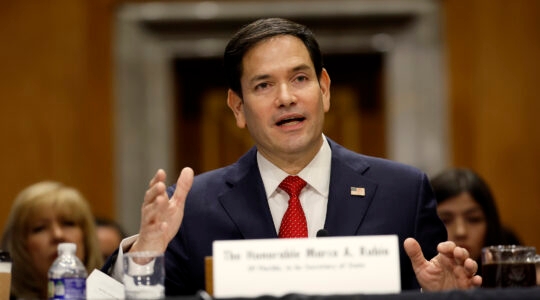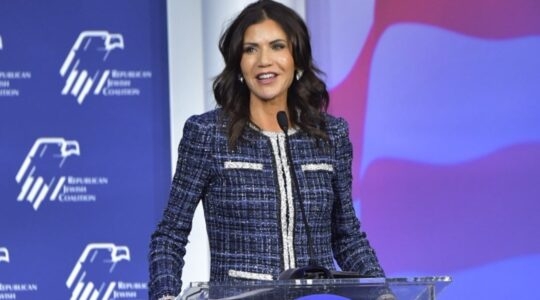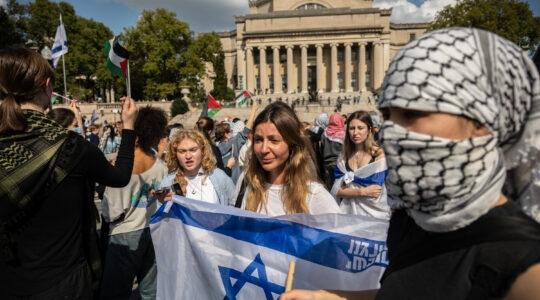NEW YORK (JTA) – Josh Fine grew up Conservative – day school, USY, summer camp, the works. His wife, Julie Geller, grew up Orthodox.
They moved to Denver four years ago and couldn’t find a synagogue they liked, so the young couple created their own: Na’aleh, a pluralistic, non-denominational minyan, or prayer community, for young, Jewishly literate Denverites.
The minyan holds services the first Friday night of each month and on most Jewish holidays. There are no dues, no building fund, no religious school, no rabbi and no institutional structure of any kind, just spirited, song-filled worship in Hebrew led by a core group of about a dozen young Jews aged 25 to 35.
“We’re a very diverse group,” says Fine, 32. “The only thing we have in common is our age.”
When the minyan doesn’t meet, some of them attend an Orthodox synagogue, others try Conservative services and others stay home. Sometimes they put up a mechitza, a ritual barrier separating men and women. Sometimes they don’t.
Fine says the minyan is “constantly evolving” and searching for meaningful religious expression that retains the fluidity and independence these young Jews are used to in the rest of their lives.
“My generation, we do things ourselves a lot,” Fine says. “No one I know goes to a travel agent to book a trip. We book it online. That’s true in every aspect of our lives.
“In terms of our spirituality and religious expression, why should we go someplace where other people tell us how to be spiritual? Why not do it ourselves?”
Na’aleh is part of a vibrant new phenomenon in Jewish life: the rise of more than 80 independent minyans, rabbi-led prayer communities and other alternative spiritual communities across the United States and Canada.
These loose-knit communities are defined by their inclusiveness, pluralistic nature, intense worship style, fluid organizational structure, high Jewish literacy and fierce aversion to labels.
And they’re growing fast. In 2001 there were 15. Their numbers have soared more than five-fold, with new communities spreading out from New York, Washington, D.C., and Los Angeles to Boston, Denver, San Francisco and Seattle, connecting thousands of young Jews through e-mail lists and word of mouth.
What was known about this phenomenon had been anecdotal until this week, when the results of the first national study on it were released. Along providing with the numbers of these groups, the study presents the first clear picture of who these young Jews are and what they are seeking.
The 2007 Spiritual Communities Study, conducted by Hebrew Union College-Jewish Institute of Religion sociologist Steven Cohen on behalf of the S3K Synagogue Studies Institute and Mechon Hadar, is based on 1,354 responses to a Web survey posted this summer.
Key findings include:
* Most participants are under 40 and unmarried; two-thirds of them are women; 40 percent grew up Conservative;
*A majority went to day school, Jewish summer camps and Hillel;
*They are comfortable with Hebrew and know Israel – more than half of those in independent minyans have spent more than four months on an Israel program;
* They like worship – most attend services at least once a month, and two-thirds pray with more than one congregation;
* They tend to be socially progressive yet religiously traditional, illustrating the Gen-X phenomenon of the “observant liberal” – one minyan, for example, forbids the eating of food that has been transported on Shabbat while declaring itself “queer friendly.”
Another key feature appears to be that news of these new prayer groups spreads through social networking rather than institutional structures.
Yehuda Kurtzer, co-founder of the Washington Square Minyan in Brookline, Mass., notes that most of the founders of the key minyans know each other from college or from attending each other’s worship services.
“You’ve got a handful of individuals who are extremely well connected, the nodes of a social network,” he says. “Otherwise, how could a minyan start with a few people on the Upper West Side and within months have an e-mail list of 3,000 people?”
Shawn Landres, research director at Synagogue 3000, an organization working to transform synagogues, says he “wasn’t surprised” at the rapid growth of the emergent communities.
“The Internet and Web technology, and the low cost of overhead makes it very easy for a small number of people to get together regularly for worship,” he says.
What did surprise Landres is how few have failed – just 20 in the past decade.
“That’s an incredible success rate,” he says. “It shows that communal spirituality is alive and well in American Jewish life.”
While many in the organized Jewish world are looking to social justice programs as a way to attract and retain younger members, survey respondents said they are seeking first a warm social community and second a meaningful worship experience in these minyans.
More than 95 percent have been to each others’ homes for a Shabbat meal, a statistic that Elie Kaunfer, a founder of New York’s Kehilat Hadar, one of the first independent minyans, finds “particularly striking.”
Social justice is important to these people, survey organizers say – it’s just that they don’t look to their prayer community to provide that outlet.
Landres, a member of the IKAR rabbi-led spiritual community in Los Angeles, says going to worship services gives him “the spiritual sustenance” for the social action work he does via other groups such as the Progressive Jewish Alliance.
“We don’t have to be all things for all people,” Kurtzer says.
Minyan participants are highly involved in Jewish communal life, including federation and Jewish community center activities, and in Jewish culture. Cohen noted that their Jewish involvement exceeds that of regular synagogue members, as measured by the 2000-2001 National Jewish Population Study.
This communal involvement, and the participants’ high levels of Hebrew and Jewish literacy, is the result of years spent in day schools, summer camps, Hillels and Israel programs. It shows that the Jewish community is “seeing the fruits of its communal investment” in those institutions, Kaunfer says.
But instead of joining the organized synagogue world, he continues, “after going through all those institutions, these young Jews are saying, I need to create something on my own.”
That refusal to affiliate has led movement leaders to criticize the independent minyans as a destructive force in Jewish denominational life. Most of that criticism has come from Conservative and Orthodox leaders, even though the study reveals that the Reform movement is the biggest “loser” in terms of identification.
Many minyan participants raised Orthodox or Conservative still identify as such, even if the minyan itself is not institutionally affiliated. But virtually all of those who were raised Reform no longer identify with that religious stream: Less than 3 percent of those involved with independent minyanim consider themselves Reform Jews.
“A lot of the communities follow a traditional liturgy,” says Kaunfer, an ordained Conservative rabbi. “The way they innovate is with music, but the service itself is in Hebrew.”
This may, the study organizers write, “suggest a basic incompatibility” between Reform Judaism and the emergent communities, and presents a challenge to Reform leaders seeking to hold onto its most involved young people.
(For results of the The 2007 Spiritual Communities Study, go to www.jewishemergent.org/survey.)
JTA has documented Jewish history in real-time for over a century. Keep our journalism strong by joining us in supporting independent, award-winning reporting.





